Yorkshire (Woollen District) Electric Tramways
History
This standard-gauge, overhead electric tramway system was part-owned and wholly operated by the Yorkshire (Woollen District) Electric Tramways Company, a subsidiary of the much larger British Electric Traction Company (BETCo), which at its zenith either owned, part-owned or leased almost 50 tramway concerns across the British Isles.
From the late 1890s onwards, the BETCo had been aggressively purchasing horse and steam-operated tramways with the intention of converting them to electric traction, as well as promoting schemes for completely new electric tramways. It first became interested in the Heavy Woollen District, the area around Dewsbury and Batley in 1898, successfully acquiring powers to build tramways in the area in 1901 and 1902 under various Spen Valley Light Railway Orders. A steam tramway — owned by the Dewsbury, Batley and Birstal Tramway Company — had already been operating in the area for over 25 years, but was making no plans for electrification. The local councils (Batley Corporation, Birkenshaw UDC, Birstall UDC, Dewsbury Corporation, and Gomersal UDC) had a right to buy the tramway within their respective boundaries in 1901, a step which the BETCo appears to have encouraged, striking deals with all the councils (crucially bar Batley) for them to notify the DB&BTCo of their intention to buy the tramway, but to eventually lease it to the BETCo. Although the DB&BTCo attempted to resist having its tramway municipalised, there was absolutely nothing it could do to stop the councils exercising their legal right.
Batley Corporation was, however, keen to build its own electric tramway system — in addition to the portion of the steam tramway it would eventually own — and acquired powers to do so in 1901, despite objections from the BETCo. Rather than operate the system itself, it seems the corporation was predisposed to lease it to the BETCo, approaching them on this matter on the 13th November 1901. Six days later, on the 19th November 1901, the BETCo registered a subsidiary company — the Yorkshire (Woollen District) Electric Tramways Company — to take-over all its powers in the Heavy Woollen District, and to build, lease and operate the new electric tramways.
The BETCo also turned its attention to the steam tramway company, a successful offer being made to its shareholders in late 1901, with control effectively passing to the BETCo on the 24th February 1902, when the DB&BTCo's directors and the manager all resigned in favour of BETCo appointees. Unfortunately, by this time the BETCo found itself involved in an increasingly acrimonious series of disagreements with Batley Corporation, some of them fundamental and others trivial. Construction of the company lines began on the 15th April 1902, with work on the Batley Corporation system commencing shortly afterwards.
By 1903, the dispute showed no signs of ending, the corporation having ordered its own tramcars, as it now intended to operate its own system. All this was to have serious consequences for the Y(WD)ETCo's main line from Dewsbury to Cleckheaton, which not only ran through Batley territory, but which also needed to share the same road (Halifax Road) as the Batley system and the same lines, the corporation being empowered to build the track in the direction of Dewsbury, and the company in the direction of Cleckheaton.
The company's first electric services commenced on the 18th February 1903 (on three routes outside Batley), but by the time the main line to Cleckheaton was ready to open, the two parties were still at loggerheads, so it had to be operated in two disconnected sections. Fortunately, common sense ultimately prevailed, agreement being reached in the summer of 1903 for the company to lease the corporation's newly built lines, with the latter also agreeing to withdraw its objections to the company's application for powers to convert the steam tramway to electric traction (these were duly granted on the 19th August 1903). Further Y(WD)ET lines were opened on the 29th July 1903, including the missing section along Halifax Road, with the corporation system opening on the 26th October 1903 following the arrival of its trams, which were thereafter operated by the company, as per the agreement.
The local authorities finally took possession of the steam tramway on the 7th June 1905, reconstruction commencing on the 10th July 1905 at the Gomersal end of the line and proceeding in sections. The last steam services are thought to have been withdrawn around the 26th September 1905, with electric services over the first reconstructed section commencing on the 28th September 1905.
With the reconstruction of the old steam tramway, the system operated by the Y(WD)ETCo reached its maximum size of 22.54 miles, 12.25 miles owned by the company, 6.27 miles by Batley Corporation, 2.94 miles by Dewsbury Corporation, 0.93 miles by Birstall UDC, 0.14 miles by Gomersal UDC (Spenborough UDC from 1914) and 0.01 miles by Birkenshaw UDC. The company at various times held powers for further extensions, some to connect with neighbouring systems, though none were ever built. Although the system met the tracks of the Dewsbury, Ossett and Soothill Nether Tramways at Dewsbury Market Place, the tracks were never connected; likewise at Birkenshaw, where the system met Bradford City Tramways, the difference in gauges there preventing through running.
The system was centred on Dewsbury, from where lines ran: southwards to Thornhill; southwestwards to Ravensthorpe; northwestwards through Heckmondwike to Liversedge, where the line divided, one line running westwards to Hightown, a second northwestwards to Cleckheaton (Moorend) and a third northwards through Clough Mill to Birkenshaw (Halfway House); and the old steam line northwards through Batley and Birstall where it met the Birkenshaw line at Clough End. The Batley Corporation lines were roughly 'H'-shaped, each upright running northeastwards from the Cleckheaton main line to join the Birstall line, one via Healey Lane and Mayman Lane, the other via Thorncliffe Road, Track Road, Purwell Lane and Hick Lane; the cross-piece connecting the two running along Wellington Road.
Although the tramway was profitable, results prior to the Great War were not as impressive as had been hoped. The company nevertheless kept its track and vehicles in good order, and strove to provide a decent service, resisting pressure from the councils, who like many across the country did not seem to understand tramway companies' reluctance to run unremunerative services.
Like most tramways, the Y(WD)ET was impacted by the Great War, chiefly through the loss of men (and their skills), which led to reduced maintenance, but also from severe difficulties sourcing rails and tramcar spares. The Great War also brought significantly increased loadings, which reached a peak in 1920 that was double that achieved in the first decade of operation. Although the numbers dropped a little during the troubled economic years of the early 1920s, they were still very healthy, with the system returning healthy profits.
The company acquired 12 second-hand trams from Sheffield Corporation Tramways in 1919/20, and in 1921 began a comprehensive overhaul of its entire fleet of around 80 vehicles. Although the company had introduced omnibus services as early as 1914, it did not build on these, even though they were successful, instead withdrawing them completely in 1921. By the following year, however, there had been a change of heart, the company once again introducing motorbus services and thereafter expanding them steadily, preferring to acquire local independent operators rather than entering into mutually ruinous competition. The situation was certainly helped by the local authorities, who had a stake in the tramway (either owning track or receiving income in the form of rates) which made them reluctant to licence motorbus competitors. This enabled the motorbus side of operations to expand, including the provision of joint services (e.g., with Huddersfield Corporation on the 15th March 1926), whilst preserving the tramway from the excesses of unregulated competition.
By the late 1920s, with the track wearing out and with three of the five local authority leases expiring in 1933, the company turned its thoughts to the future, enquiring whether the larger councils would be interested in purchasing the tramway. This offer was, however, soon withdrawn following the acquisition of a stake in the company (in December 1929) by two railway companies (the LMS and LNER), both of which operated buses (as wells trains) and were interested in delivering an integrated transport offering. The die was now set, and though the company ended up operating another tramway — following the BETCo's acquisition of the DO&SNT's parent company on the 22nd July 1930 — two months later on the 22nd September, a proposal was made to the councils to abandon the Y(WD)ET and convert it to motorbus operation.
Although there was significant dissent amongst the various councils and councillors, with Batley looking into taking over the tramway (at least operation of its own tracks), agreement was finally reached with the company not to oppose its tramway abandonment bill, which was duly passed on the 8th July 1931. The first tramway closure took place on the 19th March 1932, with more following in 1932, 1933 and 1934, the last tram of all running on the 31st October 1934 on the main line to Cleckheaton.
The following year (1935), the name of the company was changed the Yorkshire Woollen District Transport Company.
Uniforms
The photographs below clearly show Y(WD)ETCo staff wearing the familiar and largely regulation BETCo uniform. Although jackets appeared to vary somewhat between BETCo systems, as well as across the decades, the cap badges, collar designations and buttons invariably followed a standard pattern. The tunics initially issued to Y(WD)ETCo staff were double-breasted, with four pairs of buttons (of the standard BETCo pattern — see link) and lapels. The latter probably carried system initials on both sides (’Y W D T’ by analogy with other BETCo systems), almost certainly embroidered, with the overall effect being vaguely naval in appearance. The tensioned-crown peaked caps bore standard brass BETCo ‘Magnet & Wheel’ badges (see below), underneath which an employee number was worn, in individual brass numerals.
The naval-style jackets were quickly superseded by single-breasted jackets with five buttons, a breast pocket (with button closure) and stand-up collars; the latter carried individual letters on the bearer's right-hand side (probably ’Y W D T’, though these cannot be made out with certainty on the photographs below) and an employee number on the left-hand side, all presumably brass. At some point prior to the Great War a decision was taken to dispense with the employee numbers on the caps, and in later years (possibly around the time of the Great War), the collar insignia too, leaving no means of employee identification; this situation was in marked contrast to the general BETCo policy.
Tramcar staff were also issued with long, double-breasted greatcoats; these garments did not carry any insignia.
Inspectors wore single-breasted jackets with hidden buttons (or more likely a hook and eye affair), slit pockets (probably four in total) and stand-up collars; the latter bore 'Inspector' or 'Chief Inspector' on both sides in embroidered script lettering. The jacket and the pockets were all edged in a finer material than the main body of the garment. The tensioned-crown peaked caps bore the standard ‘Magnet & Wheel’ cap badge, below which was a hat band bearing the grade — either 'Inspector' or 'Chief Inspector' — in embroidered script-lettering.
Female staff were employed in significant numbers (as conductresses) during the Great War to replace male staff lost to the armed services. These ladies were issued with long, tailored, double-breasted jackets with four pairs of buttons, high fold-over collars., and a long matching skirt. The jackets do not appear to have carried badges of any description, though there remains a possibility that they had badges on the jacket epaulettes. Two types of headwaer were used, a dark-coloured, wide-brimmed straw bonnet, and a cloth bonnet, to which a standard BETCo badge was affixed (on a hat band on the former).
Further reading
For a detailed history of the Yorkshire (Woollen District) Electric Tramways, see 'The Tramways of Dewsbury and Wakefield' by W Pickles; Light Rail Transit Association (1980).
Images
Motormen and conductors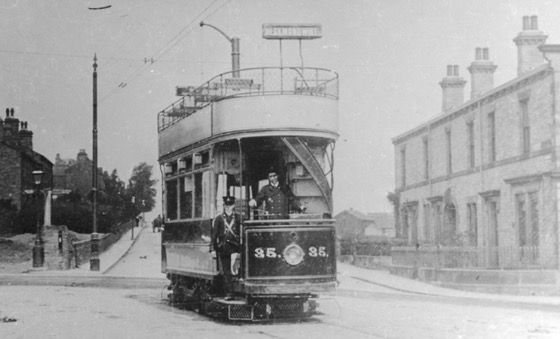
Tramcar No 35 pictured at Cleckheaton (Moorend) — photo undated, but probably taken in the first year of operation, i.e., 1903. Photo courtesy of the Tramways and Light Railway Society, with thanks to David Voice.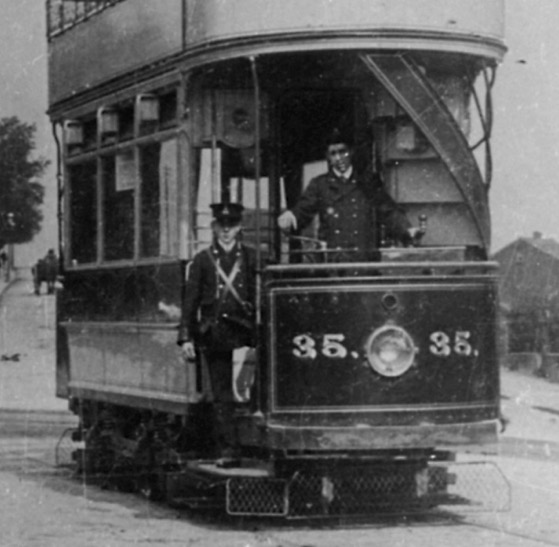
An enlargement of the above photograph showing the conductor and the motorman. The conductor is wearing a double-breasted jacket with lapels, whilst the motorman is probably wearing a greatcoat (also double-breasted). Although difficult to make out on this photograph, the conductor is wearing a standard BETCo 'Magnet & Wheel' cap badge above an employee number below.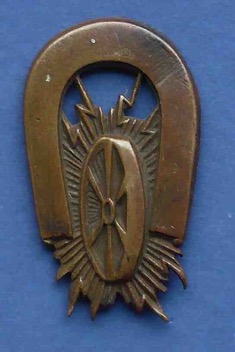
Standard British Electric Traction Company ‘Magnet & Wheel’ cap badge — brass. Author's Collection.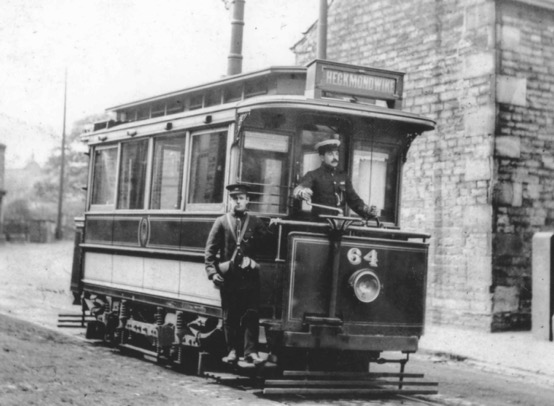
A pristine-looking Tramcar No 64 standing at the terminus at Hightown Heights, the condition of the vehicle dating the photo to 1904/5. Author's Collection.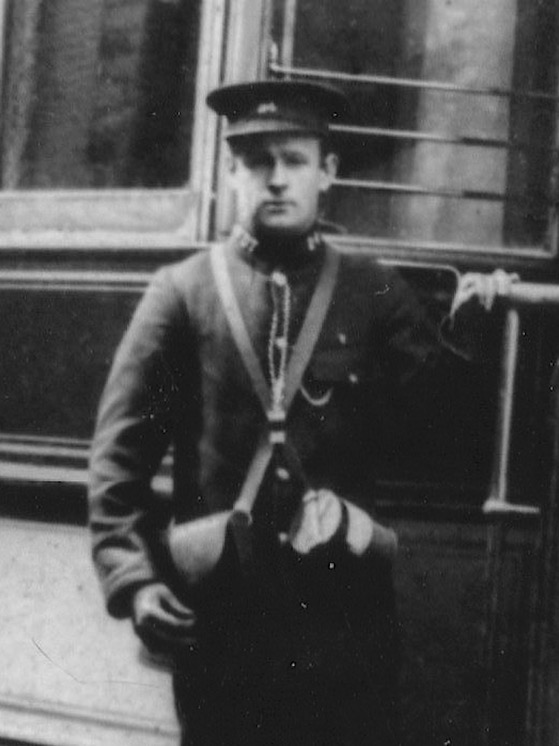
An enlargement of the above photograph showing the conductor (Employee No 24), who is wearing a single-breasted jacket with stand-up collars. His left-hand collar bears an employee number, his right-hand collar system initials, almost certainly 'Y W D T'. Although he appears not to be wearing a 'Magnet and Wheel' cap badge, this is probably hidden by the crown of his cap.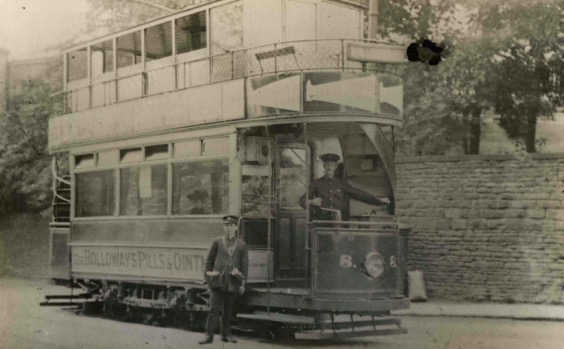
The crew of Tramcar No 8 stands in Oxford Road, Gomersal — photo undated, but probably taken in the mid-to-late Edwardian era given that it is top-covered and has a wooden rather than a mesh lifeguard. Author's Collection.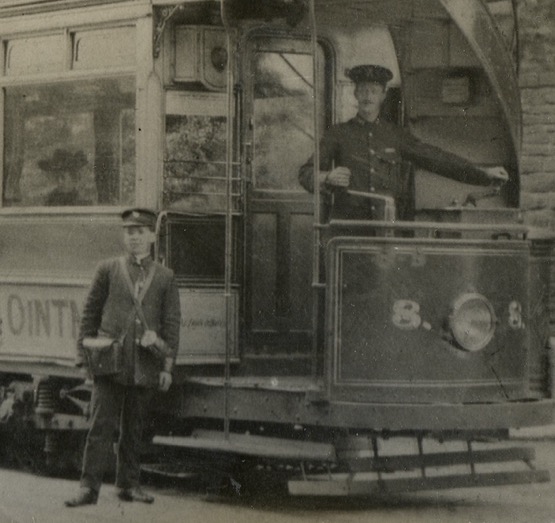
An enlargement of the above photograph showing the conductor and the motorman, both in single-breasted jackets with stand-up collars.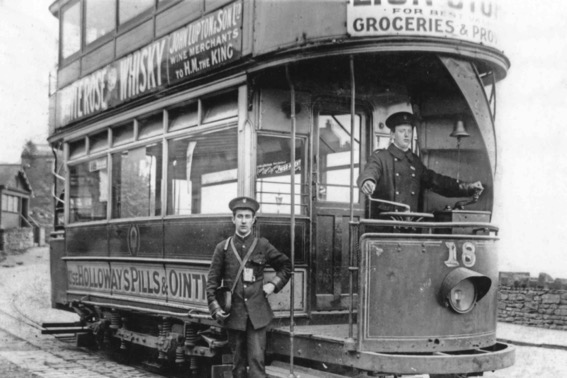
A somewhat neglected-looking Tramcar No 18 pictured at the Thornhill terminus — photo undated, but given the headlamp cowling, almost certainly taken during or shortly after the Great War. Author's Collection.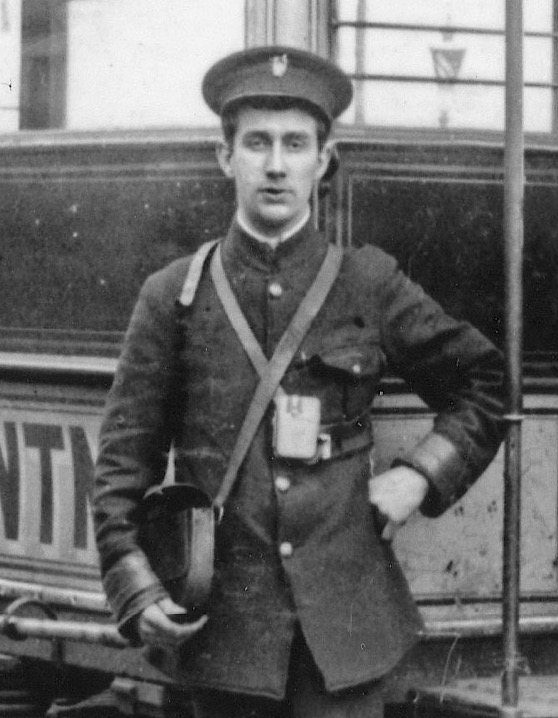
An enlargement of the above photograph showing the conductor. The only insignia on either his jacket or his cap is the BETCo 'Magnet & Wheel' cap badge. The use of employee numbers as well as system initials appears to have fallen out of use sometime before the Great War. 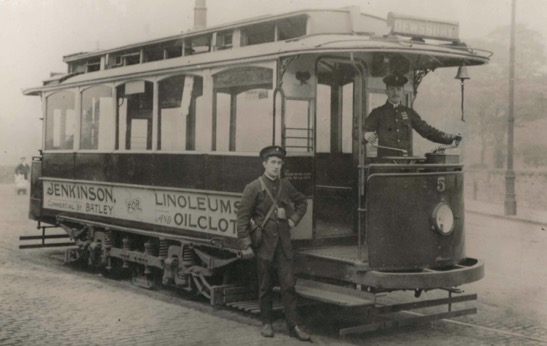
Tramcar No 5 and its crew stand at Ravensthorpe terminus — photo undated, but probably taken shortly after the Great War. Author's Collection.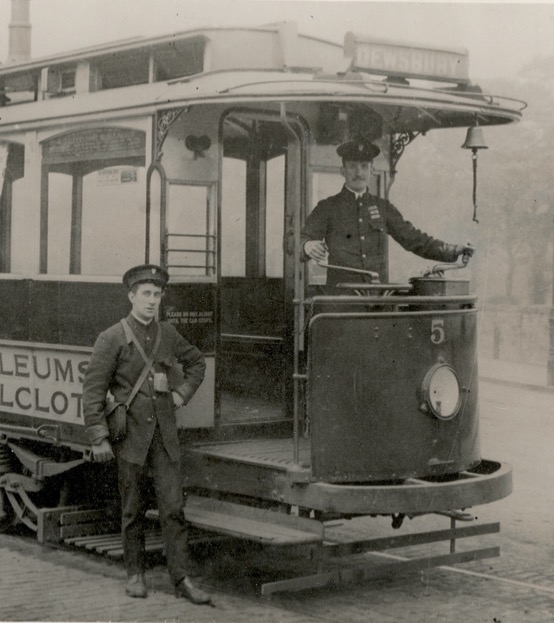
An enlargement of the above photograph showing the conductor, who would appear to be the same individual as in the photograph of No 18 above. Both men's collars are plain, with no employee numbers on their caps either.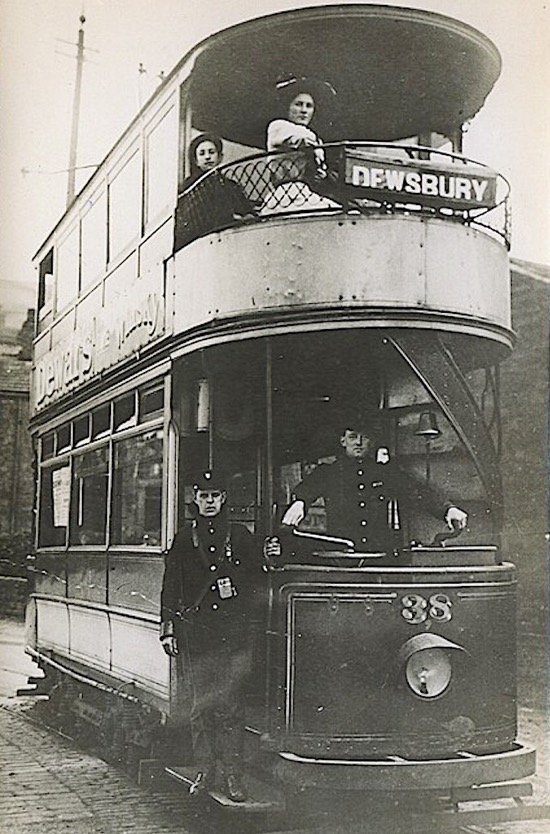
Tramcar No 38, possibly at either Ravensthorpe or Thornhill — photo undated, but given the motorman's medals and the headlamp cowling, almost certainly taken shortly after the Great War. Once again, collar insignia and employee numbers are absent. Photo courtesy of the Tramways and Light Railway Society, with thanks to David Voice.
Senior staff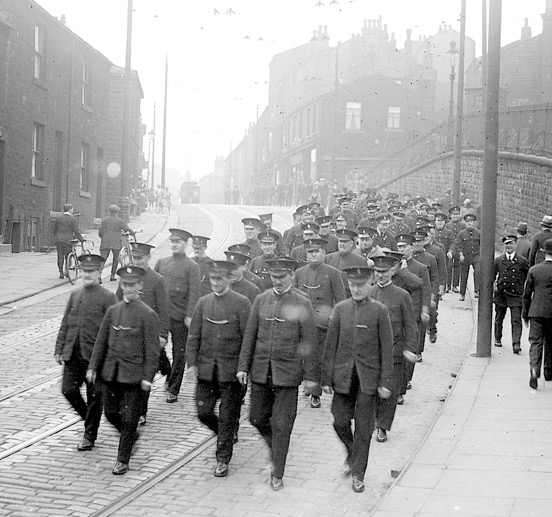
A parade of Y(WD)ET staff fronted by circa ten inspectors — date and occasion unknown, but probably taken in the late 1920s. With thanks to the National Tramway Museum.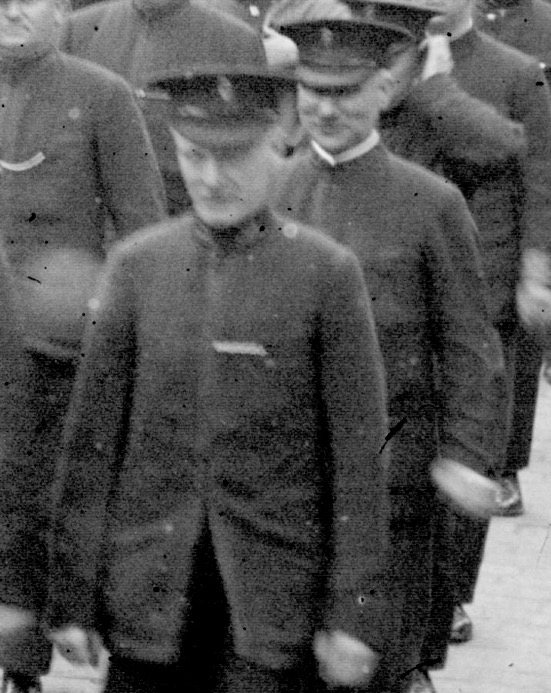
An enlargement of the above photograph showing details of the inspectors' uniforms. The individual at the front seems to have a double row of embroidered script on his collar, suggesting that he may be a more senior grade such as a 'Chief Inspector'.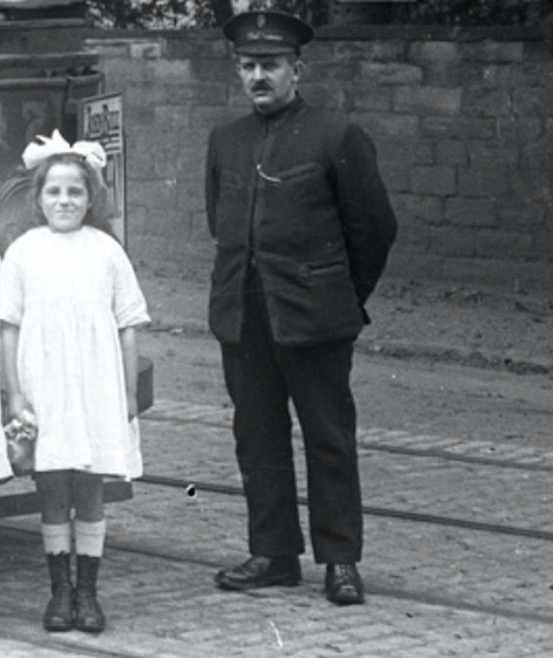
Tram No 17 pictured in Oxford Road, Gomersal, along with an individual who, judging by the two-word grade on his cap, is the Chief Inspector. The occasion was a Sunday School outing circa 1921. My thanks to David Johnson for identifying the location and the occasion.
Female staff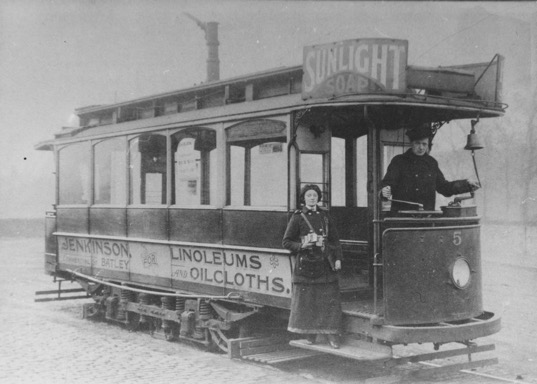
A Great War conductress and her motorman pose at what is probably the Ravensthorpe terminus around 1915/1916. Author's Collection.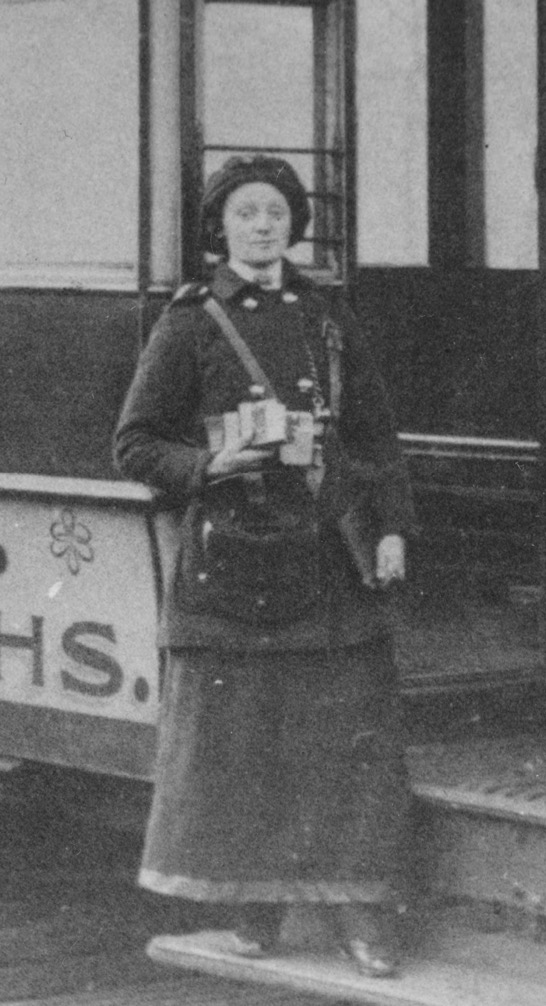
An enlargement of the above photograph showing the conductress. She is wearing a double-breasted jacket with high, fold-over collars and a long matching skirt, seemingly devoid of insignia. Her bonnet appears to be made of cloth, and appears to carry a small cap badge, almost certainly the standard BETCo 'Magnet & Wheel' device.